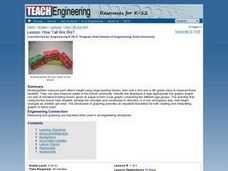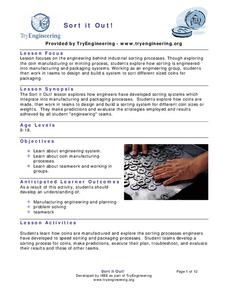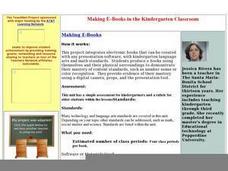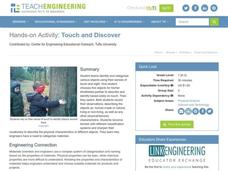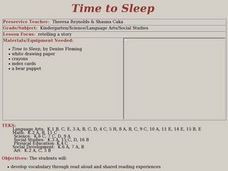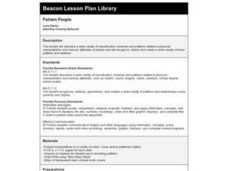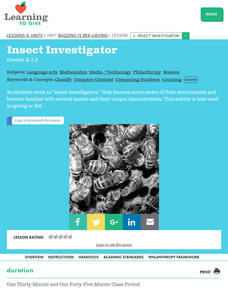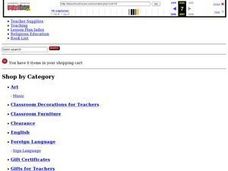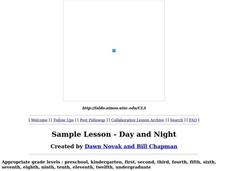Curated OER
The Nature of Mathematics
Young scholars work in groups to describe plants using numbers. In this number lesson, students use numbers to define plants and then use numbers to write descriptions of themselves.
Curated OER
Rubber Gardens
Students recycle discarded automobile tires and create gardening sites for limited space areas.
Curated OER
A Worm World
Young scholars maintain a compost bin and build a worm observatory. They design experiments relating to worms and record observations in a worm journal.
Curated OER
How Tall Are We?
Students in a Kindergarten class measure each other's height using large building blocks and then visit a 2nd and a 4th grade class to measure those students. They display the results in bar graphs, comparing the different age groups.
Curated OER
Sort It Out
Students study classification systems by sorting Legos and determining how the different pieces are classified. They list as many attributes as possible to use for sorting.
Curated OER
How Much Does a Bear Weigh?
Students estimate how many children in their class it would take to equal the mass of one adult bear. They then weigh and record their measurement on a chart to check their estimate.
Curated OER
Making E-Books in the Kindergarten Classroom
Students produce e-books using themselves and their physical surroundings to demonstrate content standards, such as number sense or color recognition. They provide evidence using a digital camera, props, and the presentation tool.
Curated OER
Rockets on a Shoestring Budgut
Students work together to create rockets on a budget. They discover the limitations that real engineers face when designing and testing their products. They discuss their findings to complete the lesson.
Curated OER
Touch and Discover
Students work together to identify and categorize objects. They have to identify the object on touch because they are blindfolded. They record their data and describe the objects once they can look at them.
Curated OER
It Counts
Students understand and reinforce how numbers are assigned to objects, as well as think about more, less, or equal values. In this lesson, students are asked to describe, compare, and classify plants. They should be able to use numbers...
Curated OER
Sink or Float?
Students predict and explore to discover which objects sink or float in fresh and salt water, predict how salt affect objects, write predictions on T chart, discuss difference between man-made and natural waters, and graph results.
Curated OER
Adaptable Mandibles
Young scholars define adaptation and highlight example of adaptation in birds and other animals. They study feeding techniques of seabirds and investigate the effect that trash has on wildlife.
Curated OER
Time to Sleep
Students develop vocabulary and retell a story that they have just listened to.
Curated OER
Away You Go
Students build Lego cars which have two different types of tire surfaces. They roll them down ramps that have both rough and smooth surfaces to determine how friction affects the car as it rolls.
Curated OER
Earth From Space
Students watch a series of programs from NASA titled "Earth From Space". After viewing the program, they identify ways NASA is researching the reasons why the Earth is changing. They discuss the various levels of the atmosphere and...
Curated OER
Look at Those Leaves!
Students research tree leaves. In this tree leaves lesson, students observe, measure, and sort tree leaves. Students examine leaves individually, in groups, and in relationship to the entire tree.
Curated OER
Winter Animal Match
Young scholars play a game. In this matching lesson, students learn about animals and their winter homes. Young scholars match cards of animals with the cards of winter homes.
Curated OER
Trash Pizza
Students identify items commonly sent to landfills and summarize percentages/fractions of different items in landfills Students create a pizza pie graph of landfill components
Curated OER
Head, Shoulders, Knees & Toes
Students, through observation of crickets, recognize and use proper names for human and insect body parts. They compare and contrast parts of human and insect body parts.
Curated OER
Pattern People
Students describe a wide variety of classification schemes and patterns related to physical characteristics and sensory attributes of people. They recognize, extend and create a wide variety of those patterns and relations.
Curated OER
Insect Investigator
Students examine and identify common insects. They observe these insects in their environment and keep track of how many they see. They use magnifying glasses and special hats to get into the role of an inspector.
Curated OER
What Comes From Corn
Students name and examine various items that are made from corn. Students compare ears of corn to Indian corn, and cook several items made from corn. Students create a popcorn picture and illustrate a book.
Curated OER
Sorting Lids
Young scholars practice sorting lids in different ways so that each group determines a sorting pattern. They examine how to work in groups while sharing ideas. They establish group work relationships that become apparent to the teacher...
Curated OER
Day and Night
Students discuss why day and night occur after visualizing a teacher-led demonstration.
Other popular searches
- Math and Science
- Math and Science Careers
- Integrated Math and Science
- Science/ Math Games
- Math and Science Activities
- Integrating Math and Science
- +Math and Science Careers
- Math and Science Plan
- Math in Science
- Math Science
- Math and Science Lessons
- Math and Forensic Science



